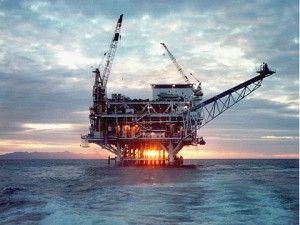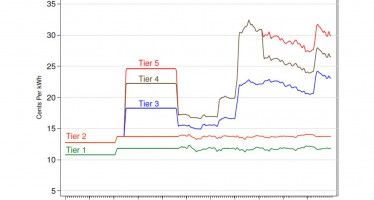Santa Barbara Oil Leases Reopened?
By WAYNE LUSVARDI
The Committee on Transportation and Infrastructure of the U.S. House of Representative approved a bill on Thursday Feb. 16. It was HR 7, the American Energy and Infrastructure Jobs Act. It would authorize the Secretary of Interior to resume oil and gas leasing off the Santa Barbara/Ventura and Santa Maria coasts beginning no later than July 1, 2014.
But this would only be on seven dormant oil and gas lease sites that were previously approved but abandoned due to litigation.
With gasoline prices rising, the timing couldn’t be better news. Gas prices reached $4.19 per gallon in Ventura County on Feb. 16. Fresno Republican Congressman Jeff Denham said, “There is no denying that gas prices are too high and major infrastructure projects are needed immediately.”
Democratic Objections Overblown
California Democratic Rep. John Garamendi of Walnut Creek quickly seized on the opportunity to blow the Republican-controlled House Committee’s action out of proportion. Interviewed by Southern California Public Radio, Garamendi claimed “there is a probability of oil spills,” and the approval pushes “aside the Federal Land Policy Management Act, the Endangered Species Act, and the Energy Policy Act.” Congresswoman Grace Napolitano, D-Norwalk, echoed Garamendi’s objections.
But a reading of Sec. 17304 of HR 7 clearly indicates new oil and gas leasing would only be allowed from existing offshore infrastructure or onshore-based drilling sites, must comply with the National Environmental Policy Act, and onshore horizontal drilling — “fracking” — would not be authorized. The bill also specifically bans any drilling or leasing off the Northern California coast.
The concern that the bill will usurp the California Coastal Zone Management Act — the Coastal Commission — from reviewing offshore leasing activities is also political overkill. Drilling would only occur on dormant lease sites and would still undergo an environmental review.
Rep. Tom McClintock, R-Elk Grove, said oil seeps have occurred naturally in the Santa Barbara Channel and elsewhere along the coastline for thousands of years. McClintock said the Spanish explorer Cabrillo noted a large oil spill off Santa Barbara in 1542. The Chumash Indian Tribe also derived their name from the tar deposits that washed ashore
Pelosi Already Approved Santa Barbara Oil Re-Leasing in 2008
To get a broader perspective on the controversial coastal oil drilling issue one needs to understand a little history of coastal oil drilling, as well as statements from politicians.
The California State Lands Commission controls mineral resources within 3 nautical miles of the coastline. The Lands Commission halted further leasing of offshore oil and gas tracts after the Santa Barbara oil spill in 1969. The California Coastal Sanctuary Act passed in 1994 also banned new leases.
Nonetheless, federal offshore leases continued through 1984. At that time the U.S. Congress shut off any administrative funds for new leasing off California. This moratorium was renewed every year until 2008, when an appropriations bill passed both the House and Senate under House Speaker Nancy Pelosi, D-Calif., and Senate Majority Leader Harry Reid, D-Nev. Despite the ban being lifted by Democrats, no new leases have transpired.
Previously, the state of California stopped the federal government from leasing on 36 federal leases authorized prior to the congressional moratorium. Twenty-nine of the old leases were voided and lease commissions were paid. The other seven leases reportedly have never been resolved and are dormant.
The U.S. Minerals Management Service estimates that the seven dormant leases contain one billion barrels of recoverable oil and 500 billion cubic feet of recoverable natural gas. (Minerals Management Service: Undeveloped leases.)
Starting in 1990, there was a series of Executive Presidential Orders that gave these dormant leases two “red lights” followed by a “green light.” President George H.W. Bush banned new federal offshore oil leasing from 1990 to 2000, including in California. In 1998, President Bill Clinton extended this moratorium. However, in July 2008, President George W. Bush rescinded the executive order. On December 1, 2010, President Barack Obama issued an executive order banning oil leasing in the Gulf of Mexico and off both the Atlantic and Pacific coasts for five years.
Reacting to the recent House Committee approval of H.R. 7, even Garamendi said that “what was done in 2008 by the Bush Administration is quite satisfactory. Get out of the way and go forward.” Maybe Democrats need to create a Republican bogeyman in order to get new oil tax revenues?
Santa Barbara Democratic Rep. Lois Capps was obviously pandering to her constituency when she said, “Californians have spoken loud and clear. We do not want more drilling off our shores. We were outraged by the damage to the environment … to our economy” from the 1969 Santa Barbara oil spill. But Capps failed to mention that both Pelosi and Reid had previously approved re-opening these leases.
Oil and Gas Already Being Drilled Off the Coast
If you read newspaper headlines of this story you might get the false impression that there currently is no oil drilling along the coast.
Ventura Star: “House Passes Legislation to Allow Oil Drilling Off Ventura Coast.”
Southern California Public Radio: “Oil Drilling Off California Coast Approved by House Panel.”
Los Angeles Times Blog: “House Republicans Push New Oil Drilling to Fund Road Projects.”
The reason the public often mistakenly believes that there are no oil platforms off the California coast is that they are mostly beyond the visual horizon or aesthetically disguised in harbors.
But there are nine active offshore drilling sites remaining in state and Federal waters, including one on an artificial island in the Santa Barbara Channel, according to Wikipedia.com. Additionally, there are three offshore oil platforms off the Wilmington Oil Field in the San Pedro/Long Beach Harbor erected on disguised platforms.
There are 23 offshore platforms still remaining in Federal waters, which have produced 22 million barrels of oil and 21 billion cubic feet of natural gas per year. Bureau of Ocean Energy management, Pacific regiion facts and figures.
On January 29, 2009, the State Lands Commission rejected a proposal by Exxon Mobil and Plains Exploration to drill into the Tranquillon Ridge Oil Field off of Santa Barbara. This proposal involved drilling from an existing platform and no new platforms would be built. The drilling would have been solely in federal waters. Cited as a factor for the rejection by then-Gov. Arnold Schwarzenegger were the overblown media images of the Gulf Oil Spill in the Gulf of Mexico. Almost two years after the Gulf Oil Spill, the environmental aftermath of that event can hardly be found as natural microbes consumed the oil from the bottom of the sea. Nature cleaned the Gulf itself.
Curiously, the conservative Competitive Enterprise Institute opposed the use of oil and gas revenues for use in building and maintaining new roads and bridges. The reason is that this would run against the principle of “user pays” for road and bridge projects.
CA Coastal Drilling Part of Bigger Bill
HR 7 is a large $260 billion five-year transportation bill. The federal government is technically broke when off-budget future obligations to fund entitlement programs are considered. Thus, Congress is eager to create new revenue sources to fund transportation projects that are typically funded by road users. Less economic activity due to the recession and the increase in more fuel-efficient vehicles are making funding for transportation projects more difficult.
HR 7 — the American Energy and Infrastructure Jobs Act — also includes provisions to open up Alaska’s Wildlife Refuge to energy exploration and re-open the contentious Keystone Pipeline natural gas pipeline project from Canada to Texas. The entire House of Representative still has to vote on the Bill. If passed, it would move on to the U.S. Senate.
To accommodate environmentalists, California Democratic Sen. Barbara Boxer is opposed to drilling in the Santa Barbara Channel. But will she lead a rejection of HR 7 in the U.S. Senate of a needed infrastructure bill and be viewed as vetoing jobs? The U.S. Senate has not approved a budget in three years. Or will both houses approve the bill and let Obama have the hot potato of rejecting a new jobs and new revenue bill in an election year?
Will Oil and Water Mix in the Santa Barbara Channel?
Recently, Rep. Devin Nunes, R-Tulare, drafted HR 1837 — the San Joaquin River Water Reliability Act –- that would repeal U.S Senator Dianne Feinstein’s 2009 San Joaquin River Restoration Act that took water away from farmers and cities.
With a large five-year jobs bill on the table such as HR 7 it remains to be seen what compromises California Democratic politicians may be willing to make with House Republicans.
Christine Gibson is quoted in Safire’s Political Dictionary on the definition of political “horse-trading”: “The delegates debates, after-hours vote scrounging, and political horse trading found compromises between immiscible interests.”
Immiscible is a chemical term meaning “unable to be mixed.” We may find out soon if oil from the Tranquillon Ridge Field politically mixes with Santa Barbara ocean water.
Related Articles
Tiered pricing ends up subsidizing solar panels for the rich
In a new development for energy conservation, it turns out charging more for electricity, the more juice is used, could
Markets best would clean up L.A. pollution storm
This is Part 2 of a three-part series. Part 1 is here. Dec. 4, 2012 By Wayne Lusvardi In Part
Gov. Jerry Brown’s father complex
June 5, 2013 By John Seiler Calling Dr. Freud. Gov. Jerry Brown’s relationship with his later father, Gov. Pat Brown,




